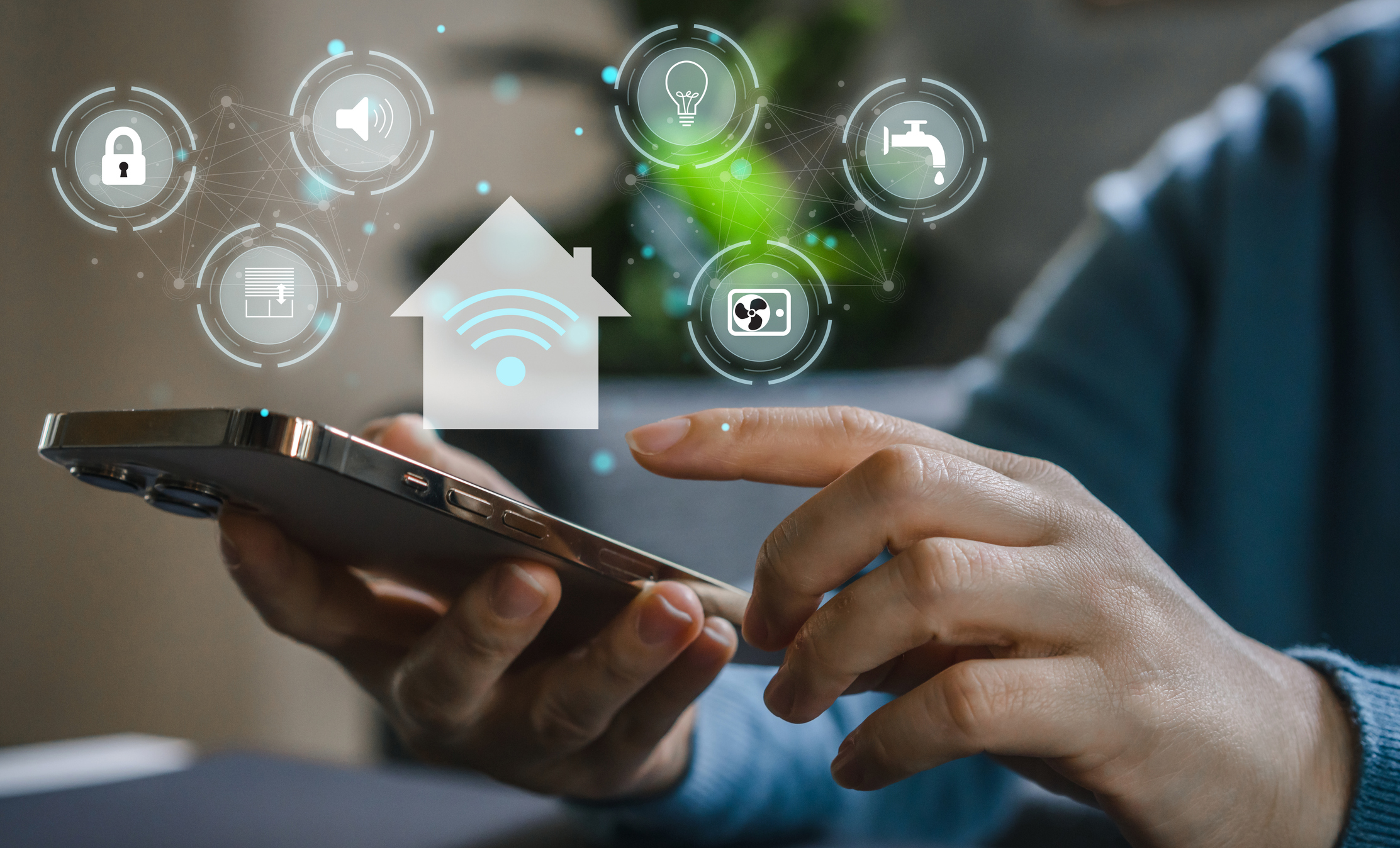What Is a Smart Home
Fri Oct 11 2024
Imagine coming home after a long day, and with a simple voice command, your lights turn on, the thermostat adjusts to your preferred temperature, and your favorite playlist starts playing in the background. This isn’t the future—it’s what smart home automation can offer you!
A smart home uses internet-connected devices to enable remote management and automation of household systems such as lighting, security, and entertainment. Different devices work together to automate processes based on the user's preferences, creating an integrated setup.
Whether it's adjusting the thermostat, controlling lighting, or managing security cameras, the system learns and adapts to provide a more personalized environment, making your home more comfortable, efficient, and secure.
How Do Smart Homes Work?
Smart homes rely on a network of devices that communicate with each other through a central hub or a smartphone app. These devices can be controlled individually or set to work together automatically. For example, you can program your lights to dim when you start watching a movie or set your thermostat to lower the temperature when you leave the house.
Smart home automation allows you to create “scenes” that control multiple devices simultaneously. For instance, a “Goodnight” scene could turn off all lights, lock the doors, and set the thermostat to an energy-saving temperature, all with a single tap or voice command.
What Are the Components of a Smart Home?
A typical smart home includes several key components:
-
Lighting: Control your lights remotely or set them to follow a schedule with smart lighting. Smart bulbs and switches can also change color and dim to create the perfect ambiance.
-
Smart Thermostats: Manage your home’s temperature from anywhere and save on energy costs by automating heating and cooling schedules.
-
Security Systems: From cameras and doorbells to smart locks, a smart surveillance system can monitor and control who enters your home, even when you’re not there.
-
Smart Garage Door Openers: These devices allow you to open and close your garage door from anywhere using your smartphone. You can monitor the status of your garage door, receive notifications if it’s left open, and even integrate it with other smart home systems, such as security cameras and lights.
-
Smart Appliances: Smart appliances take everyday tasks to the next level by adding automation and connectivity. Refrigerators can suggest recipes based on the ingredients you have or notify you when you’re running low on essentials. Ovens can be controlled remotely, allowing you to preheat or adjust the temperature from your phone. Dishwashers and washing machines can be scheduled to run during off-peak energy hours, reducing costs and improving efficiency. These appliances can often be controlled by voice commands through systems like Alexa or Google Assistant.
-
Smart TVs: These TVs come with built-in apps for streaming services, the ability to connect to other smart devices, and voice control features. Many smart TVs are compatible with virtual assistants, enabling you to control other home devices, search for shows, or adjust settings hands-free.
-
Household Monitors: Smart household monitors track various aspects of your home’s environment, such as temperature, humidity, and air quality. These devices can alert you to issues like water leaks, smoke, or carbon monoxide levels, ensuring your home remains safe. They also integrate with other smart devices to take automatic actions, like adjusting a smart thermostat or activating an air purifier.
-
Smart Plugs: Smart plugs give you the ability to control non-smart devices by turning them on or off remotely through your phone or voice commands. You can schedule appliances, such as lamps or coffee makers, to turn on or off at specific times, and monitor energy usage, helping you save on electricity bills.
-
Voice Assistants: Devices like Amazon Alexa, Google Assistant, or Apple’s Siri serve as the control center for your smart home, allowing you to manage everything with just your voice.
-
Speakers & Sound Systems: Transform your home into an immersive sound experience with whole home audio systems. Whether you’re playing music in every room or setting the perfect soundtrack for a gathering, smart speakers and integrated sound systems bring your favorite tunes to life.
-
Motorized Window Treatments: Adjust your blinds or shades with a touch of a button or voice command. Motorized window treatments offer convenience, improve energy efficiency, and add a touch of luxury to any room.
Benefits of Smart Homes
-
Convenience: Convenience: Smart home devices streamline task management, automating everyday routines and reducing manual effort. Whether it’s managing lighting, adjusting the thermostat, or controlling appliances, these systems help users execute tasks efficiently.
-
Energy Efficiency: Smart thermostats, lighting systems, and appliances optimize energy consumption by only operating when necessary, helping to reduce waste and lower utility bills. These systems can be programmed to adjust automatically based on occupancy or time of day, ensuring energy is used efficiently.
-
Enhanced Security: Smart security systems significantly enhance home protection with features like motion detection, real-time video surveillance, and instant alerts. These technologies can be monitored remotely, providing peace of mind at home or when you’re away.
-
Comfort and Customization: Smart home systems allow you to tailor your living environment to suit your preferences. From creating the perfect ambiance with adjustable lighting to setting the ideal temperature, these systems adapt to your preferences, ensuring maximum comfort.
-
Resource and Cost Savings: Smart home devices also help conserve resources like water and energy. For example, smart irrigation systems monitor weather conditions and soil moisture to water plants only when needed, while smart washing machines and dishwashers optimize water usage based on load size. These innovations promote sustainability and lead to significant cost savings over time.
-
Future-Proofing Your Home: As technology evolves, a smart home can easily adapt. New devices and features can be added to your system, ensuring your home stays up-to-date with the latest innovations.
-
Increased Home Value: Smart home features are becoming increasingly desirable in the real estate market. Equipping your home with smart technology can increase its value.
-
Accessibility: For individuals with mobility issues or disabilities, smart home technology can greatly improve accessibility. Voice-controlled devices, automated lights, and smart locks can make daily activities easier and more manageable.
Considerations for Smart Homes
-
Initial Cost: While smart home devices offer long-term savings, the upfront cost of purchasing and installing these systems can be significant. It's important to factor in both the investment in devices and potential installation fees.
-
Connectivity and Dependence on the Internet: Many smart devices rely on a strong internet connection to function properly. If your connection is slow or experiences outages, you may encounter disruptions in how your smart home operates.
-
Privacy and Security: With increased connectivity comes the need to ensure your personal data is secure. It’s essential to use strong passwords, enable multi-factor authentication, and stay aware of privacy settings to protect your home from potential security vulnerabilities.
-
Compatibility Between Devices: Not all smart home devices are compatible with each other, especially if they come from different manufacturers. Ensuring that the systems you choose can integrate properly requires research and planning.
Smart Technology in Commercial Buildings
Smart technology isn’t limited to homes; it’s increasingly transforming commercial buildings as well. Just like smart homes, smart buildings leverage automation and interconnected devices to enhance efficiency, security, and comfort on a larger scale.
-
Energy Management: In smart commercial buildings, automated lighting and HVAC systems adjust based on occupancy and time of day, significantly reducing energy consumption. Sensors detect when areas are vacant and adjust lighting and temperature accordingly, leading to more sustainable operations.
-
Enhanced Security: Smart security systems in commercial buildings offer advanced features like facial recognition, automated access control, and real-time surveillance. These technologies enhance the safety of employees and visitors, while reducing the need for manual monitoring.
-
Operational Efficiency: Smart buildings automate routine tasks such as monitoring elevators, air quality, and managing maintenance schedules. By integrating these systems, building managers can streamline operations and reduce costs, while also improving the comfort of occupants.
-
Sustainability: Smart buildings often include green technologies like automated water systems and renewable energy sources. These systems not only reduce resource consumption but also help businesses meet sustainability goals and reduce their environmental impact.
Should I DIY My Smart Home?
While it may be tempting to set up your own smart home system, it’s important to consider the complexity involved. Smart home technology goes beyond simply plugging in devices. Proper integration requires expertise to ensure everything works seamlessly together.
Attempting to do it yourself can lead to the following issues:
-
Connectivity Problems: Smart devices rely on a robust network connection and proper setup. Incorrect installation can cause devices to malfunction, disconnect, or even fail to communicate with each other.
-
Security Risks: Improperly configured devices can leave your home vulnerable to security breaches. Professional installers know how to set up your system securely, protecting your personal data and home network.
-
Compatibility Issues: Not all devices are compatible with each other. A professional can help you choose the right products that will work well together, avoiding frustration and additional costs.
-
Time and Effort: Setting up a smart home system can be time-consuming, especially if you’re not familiar with the technology. Professionals can handle the installation efficiently, allowing you to enjoy your smart home without the hassle.
For a truly integrated and efficient smart home experience, we recommend working with professionals. At Audio Video Experience, we handle the design and installation to ensure your smart home is set up correctly and securely. Remember, the goal of smart home automation is to make your life easier and more enjoyable.
Ready to Make the Switch? Let Us Help You!
Creating a smart home that truly works for you requires more than just buying the latest devices. Proper planning, integration, and setup are key to ensuring all your devices communicate and deliver the experience you’re looking for.
That’s where Audio Video Experience comes in. With our extensive knowledge and experience, we will design and install a smart home system that’s customized to your needs. Whether it’s integrating a whole-home audio system, installing a home theater, setting up motorized window treatments, or ensuring your security system is at its best, we’re here to make the process smooth and hassle-free.
Don’t do it alone! Smart home installation can be complex, and doing it yourself may lead to connectivity issues or even damage to your devices. Contact us today and we’ll help you transform your house into a smart home that offers comfort, security, and convenience, all tailored to your lifestyle.
FAQs: What Is a Smart Home
Does a smart home increase property value?
Yes, a smart home can significantly increase property value. Homebuyers are often attracted to the convenience, security, and energy efficiency that smart technology offers. Features like smart thermostats, security systems, and automated lighting can make your home stand out in the market and potentially lead to a quicker sale at a higher price.
Are smart homes energy efficient?
Absolutely! Smart homes are designed to optimize energy use. Smart thermostats adjust heating and cooling based on your habits, while smart lighting and appliances can be programmed to operate only when needed. This not only reduces energy consumption but also lowers utility bills, making your home more eco-friendly and cost-effective.
Are there disadvantages to smart homes?
No, there are no significant disadvantages to smart homes when they are set up correctly. While some may worry about security or complexity, working with a professional installer ensures your system is both secure and easy to use. The benefits of increased convenience, energy efficiency, and enhanced security far outweigh any potential concerns.

Copyright © 2009 - 2025 Company All Rights Reserved.
This site is protected by reCAPTCHA and the Google Privacy Policy and Terms of Service apply.
